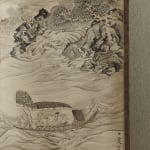Ike no Taiga (1723–1776)
View of the Red Cliff
Ink and light color on silk, hanging scroll
With authentication by Kimura Kenkado
Seals: Kasho; Sudeni senri no michi o yukedomo imada bankan no sho o yomazu
123 x 30.5 cm
182 x 33.5 cm (overall)
With authentication by Kimura Kenkado
Seals: Kasho; Sudeni senri no michi o yukedomo imada bankan no sho o yomazu
123 x 30.5 cm
182 x 33.5 cm (overall)
Further images
The subject is the “Former Ode to the Red Cliff” written by Su Dongpo. Dongpo visited the Red Cliff with his guests in 1082, where the decisive Battle of Red Cliff was fought in 208 in Eastern Han period. The man with a hat on the boat is Dongpo. One of his guests is playing a flute-like instrument dongxiao, just as described in the ode. Taiga depicted a pan pipes-like xiao instead of dongxiao in two other paintings of the same subject: one (The Works of Ike-no Taiga, cat. no. 72) painted at the age of thirty-seven and the other (ibid, cat no. 250) around his forty years. However, the instrument is changed to a dongxiao in another work (ibid, cat. no. 591) painted in his mid-forties. Taiga seemed to have been influenced by Sakaki Hyakusen in the Red Cliff subject, in which the instrument depicted as a dongxiao. As Taiga depicted a dongxiao in an earlier example (ibid, cat. no. 811) painted at the age of twenty-seven, he most likely changed from dongxiao to xiao sometime in his middle age. The resembling boat scene in the present painting and cat no. 250 implies that both were executed in the same period. The dongxiao in the present painting suggests that it may postdate cat. no. 250, in which a xiao was depicted. Notable in this painting is the intricate depiction of the rocks. A similar rock representation is found in Taiga’s The Orchid Pavilion Gathering (ibid, cat. no. 444-2) painted at the age of forty-one, which indicates that the present work probably dates to the same period.
A letter written by Kimura Kenkado is included in the storage box. It is addressed to Shukodo, probably an art dealer, who seemed to have consulted Kenkado about the authenticity of this painting. Kenkado replied that it is extremely superb, and warned that it should not be shown to many, as a lot of fakes would appear soon.
Ike no Taiga (painter; 1723–1776)
Also known as Tsutomu; Kin; Mumei; Kobin; Shishaku; Taisei; Shuhei; Okochoso; Kasho; Chikkyo; etc.
Kyoto-born mid Edo period literati painter. Kept a fan shop and taught himself the Chinese nanshuga (Southern School Painting) through the imported painting albums from China on the one hand, and received influence from the forefathers of the Japanese literati painting style, such as Yanagisawa Kien and Gion Nankai, on the other. Developed a rather original painting style, which gained him the high reputation of being the progenitor of the Japanese nanga.
A letter written by Kimura Kenkado is included in the storage box. It is addressed to Shukodo, probably an art dealer, who seemed to have consulted Kenkado about the authenticity of this painting. Kenkado replied that it is extremely superb, and warned that it should not be shown to many, as a lot of fakes would appear soon.
Ike no Taiga (painter; 1723–1776)
Also known as Tsutomu; Kin; Mumei; Kobin; Shishaku; Taisei; Shuhei; Okochoso; Kasho; Chikkyo; etc.
Kyoto-born mid Edo period literati painter. Kept a fan shop and taught himself the Chinese nanshuga (Southern School Painting) through the imported painting albums from China on the one hand, and received influence from the forefathers of the Japanese literati painting style, such as Yanagisawa Kien and Gion Nankai, on the other. Developed a rather original painting style, which gained him the high reputation of being the progenitor of the Japanese nanga.







